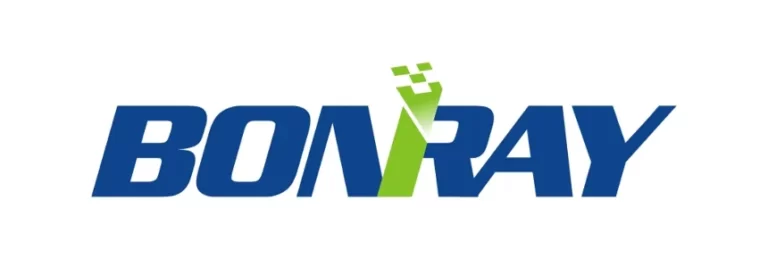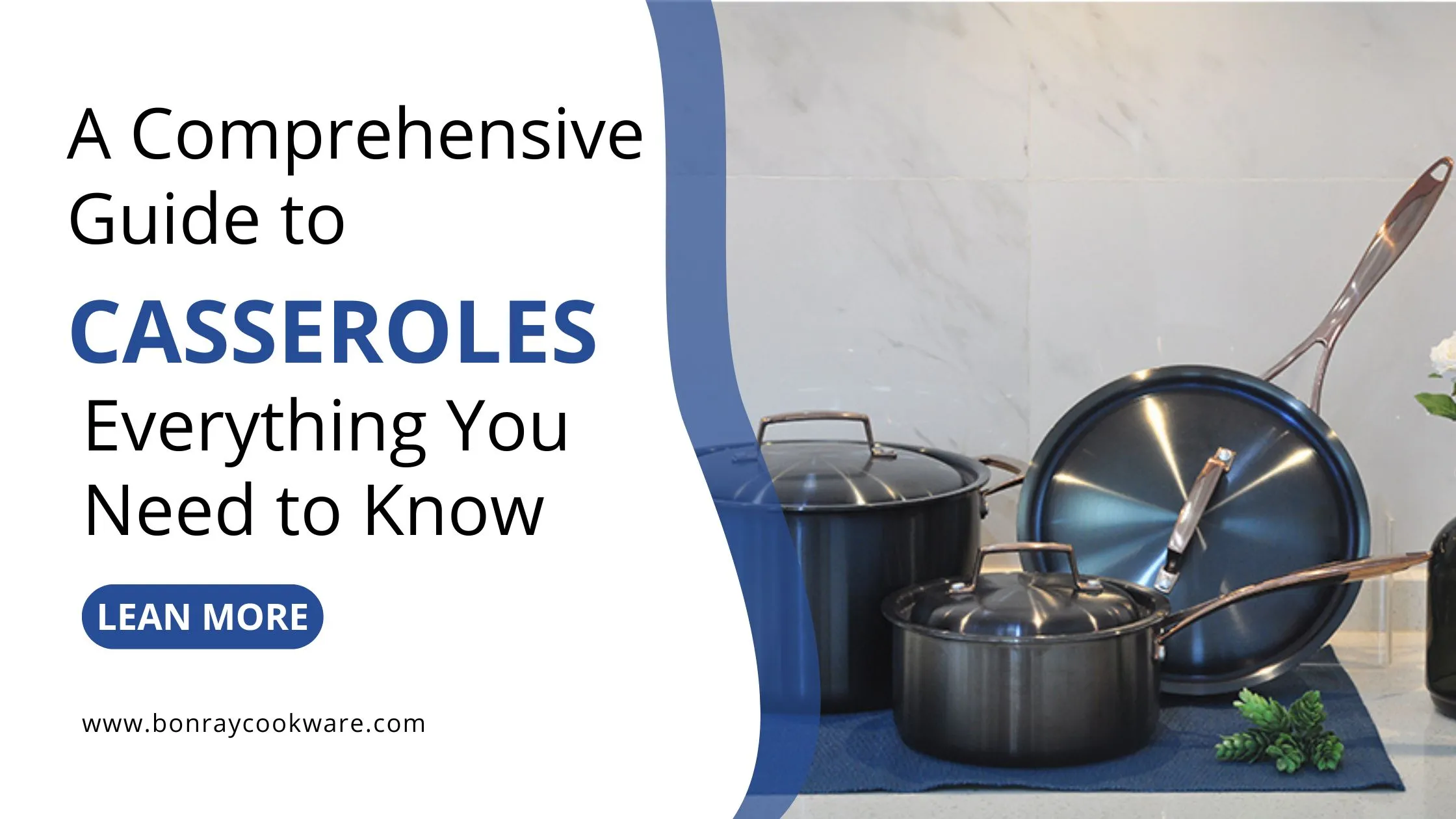A Comprehensive Guide to Casseroles: Everything B2B Partners Need to Know
Ever wondered why casseroles remain a cornerstone of commercial kitchenware collections worldwide? As someone who’s spent years in the cookware manufacturing industry, I’ve watched this versatile, oven-safe cookware solution evolve from basic utility to sophisticated culinary tool. Today, I’m excited to share everything you need to know about casseroles of bulk purchasing.
The global cookware market reached an impressive USD 30.59 billion in 2023 and is projected to grow at a robust 7.3% CAGR through 2030. Within this expanding landscape, casseroles hold a significant position, particularly in the stainless ste el segment which dominates with 27% market share. For importers, wholesalers, retailers, and brand owners, understanding the significance of casserole products isn’t just helpful—it’s essential for capitalizing on this growth.
What Makes Casserole Pots Essential in Kitchenware Industry?
Casseroles represent one of the most versatile and high-demand cookware items in both commercial and residential settings. Their multi-functionality (suitable for stovetop cooking, oven baking, food storage, and serving), durability, and cross-cultural appeal make them indispensable in any kitchenware lineup. With material innovations, design advancements, and shifting consumer preferences toward multi-purpose cookware, casseroles offer exceptional value through high turnover rates, strong margins, and year-round demand patterns. The category’s adaptability to various price points—from value-oriented to premium markets—further enhances its appeal across diverse market channels.
But there’s much more than just market statistics. Whether you’re sourcing for import, developing a private label program, or expanding your wholesale catalog, this comprehensive guide will equip you with the insights needed to make informed decisions about casserole products.
From material selection and manufacturing considerations to market trends and distribution strategies, we’ll explore every aspect of the casserole pot business. Let’s dive deeper into the world of this essential cookware category and discover how you can leverage its potential for your business growth.
Understanding Casseroles: Types and Classifications
When it comes to casseroles, one size definitely doesn’t fit all. As a manufacturer, I’ve seen firsthand how different markets demand specific configurations to meet their unique culinary needs. Let’s break down the various types and classifications of casseroles that dominate today’s kitchenware marketplace.
Definition and Basic Characteristics
Essentially, a casserole is a deep, wide cooking vessel with straight sides, usually with two handles and a tightly fitting lid. The word “casserole” refers both to cooking the dish itself and to the food prepared with it – a linguistic quirk that highlights the cookware’s indispensability to certain cooking methods.
What sets casseroles apart from other cookware is their versatility. They’re designed for multiple cooking techniques: stovetop simmering, oven baking, braising, stewing, and even serving. This multi-functionality makes them particularly valuable in commercial settings where kitchen space and equipment efficiency are critical.
Classification by Size
Size matters significantly in the casserole market, with different volumes serving distinct purposes:
Small Casserole Pot (1-3 liters): These compact casseroles are perfect for side dishes, individual portions, or specialty applications. In the wholesale cookware industry, small casseroles are particularly popular with:
- Boutique restaurants serving individual portions
- Catering operations offering personalized meal options
- Hotels providing in-room dining services
- Specialty food retailers selling cookware for small households
Medium (3-5 liters): Medium-sized casseroles, which are used in both commercial and household kitchens, can handle soups, stews, and pasta meals. They are the largest category in most cookware channels, appealing to:

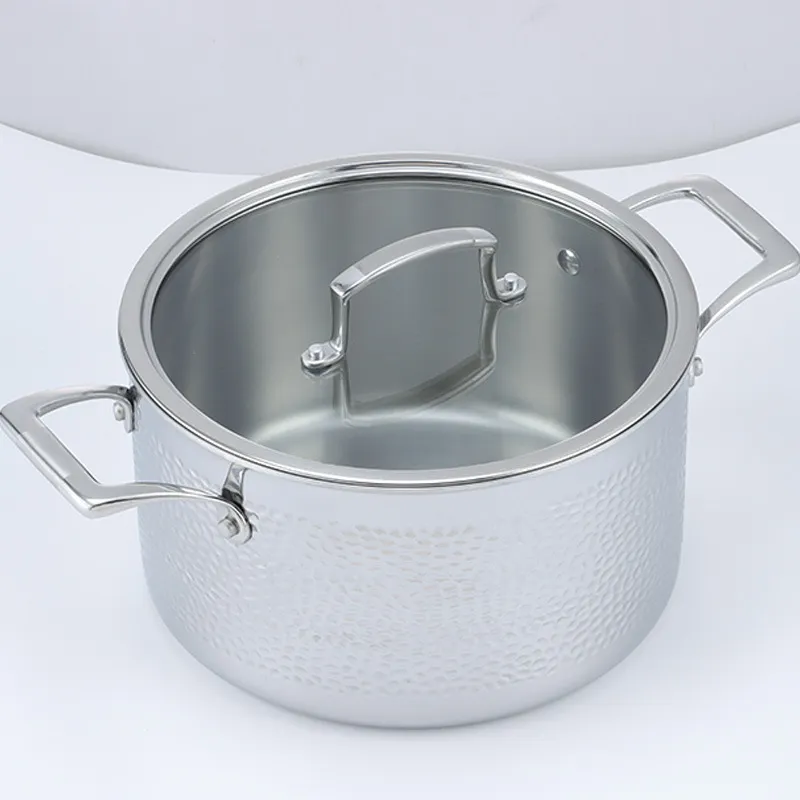
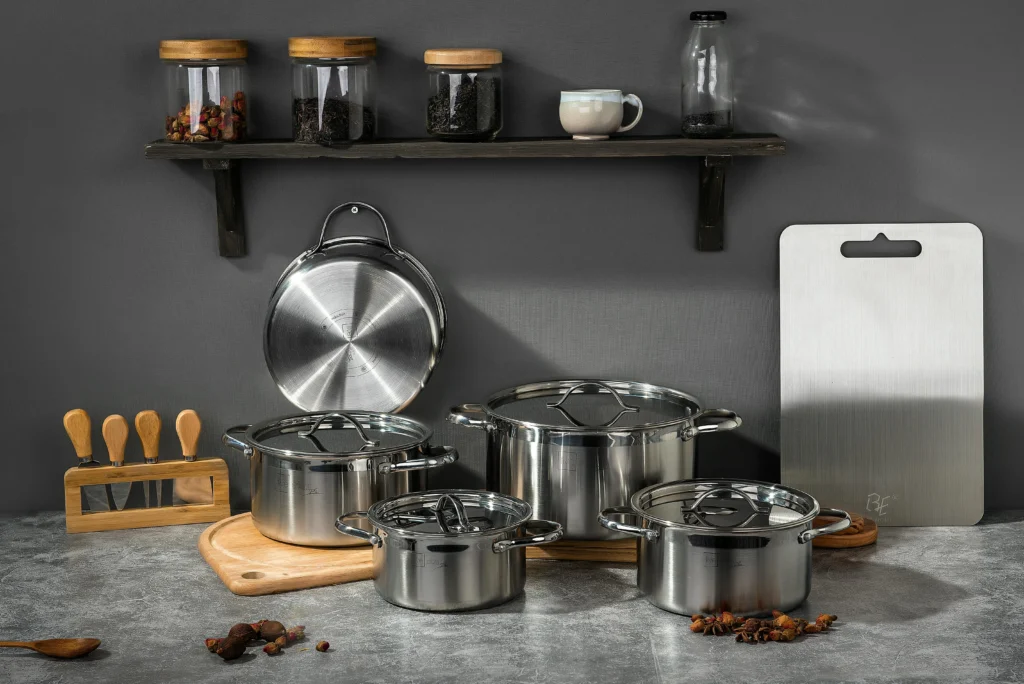
- General restaurants and cafeterias
- Institutional food services
- Standard retail offerings
- Mid-range hospitality settings
Large Casserole Dish (over 5 liters): These substantial vessels are designed for batch cooking and large-scale food service operations. Key popular markets include:



- Industrial kitchens and commissaries
- Large restaurants and buffet operations
- Food manufacturing facilities
- Wholesale clubs and value retailers targeting large families
When advising our wholesaler partners on inventory mix, we typically recommend a distribution of approximately 20% small, 50% medium, and 30% large casseroles to match typical market demand patterns.
Materials Matter: Comparing Casserole Construction
In my two decades working as a kitchenware manufacturer, I’ve learned that material selection is perhaps the single most critical decision in casserole production. It affects everything from performance and durability to price point and market positioning. Let’s explore the primary materials used in today’s casserole market.
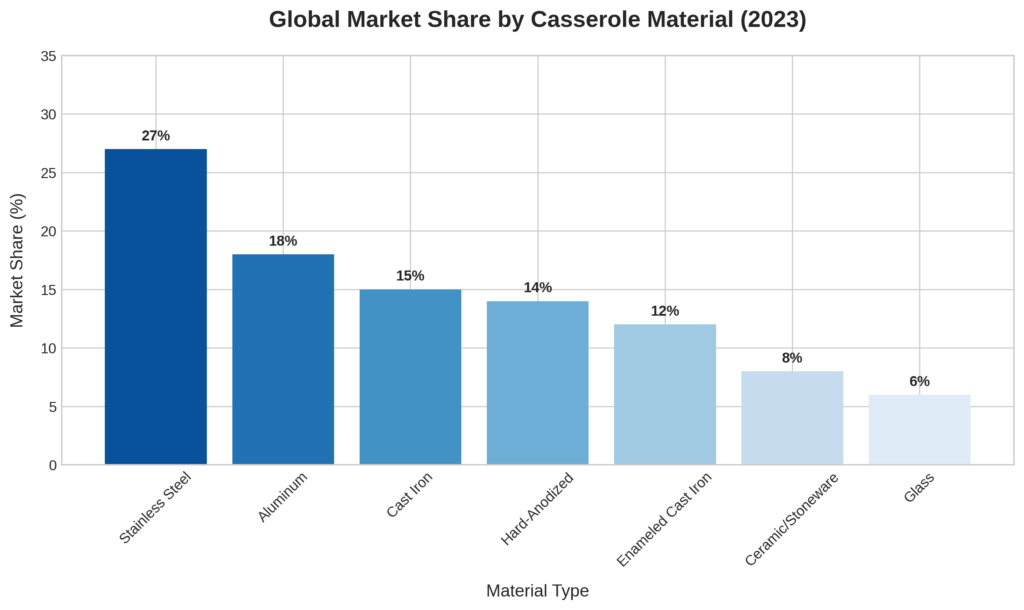
Casserole Materials Comparison Table
| Material | Market Share | Key Benefits | Limitations | Best Applications | Price Point |
|---|---|---|---|---|---|
| Stainless Steel | 27% | • Exceptional durability • Non-reactive surface • Dishwasher safe • Aesthetic versatility • Excellent heat retention | • Poor heat conductor without added layers • Potential for food sticking • Higher weight in premium constructions | • Professional kitchens • High-volume commercial settings • Mid-to-high-end retail programs • Institutional settings | Mid to Premium |
| Cast Iron | 15% | • Unparalleled heat retention • Excellent durability • Natural non-stick properties when seasoned • Develops character over time | • Substantial weight • Requires special care • Potential for rusting • Reactive with acidic foods | • Slow cooking applications • Braising and stewing • Heritage-focused retail programs • Premium gift market | Mid-Premium to Premium |
| Enameled Cast Iron | 12% | • Non-reactive cooking surface • Vibrant color options • Easier maintenance • Excellent heat retention | • Premium price points • Potential for chip damage • Heavy weight • Limited color consistency in production | • Premium retail channels • Gift-oriented programs • Specialty cooking applications • Table-to-oven | Premium |
Essential Features and Components
Beyond material selection, the specific features and components of casseroles significantly impact their performance, user experience, and market positioning. For partners developing cookware product lines, understanding these elements is crucial for creating compelling offerings that meet end-user needs.
Lid Design and Functionality
The lid is far more than just a cover—it’s a critical component that affects cooking performance, versatility, and user experience. Key considerations include:
Sealing Efficiency: The quality of the seal between lid and vessel directly impacts moisture retention during cooking. Premium casseroles feature precision-engineered fits that minimize evaporation, while some designs incorporate condensation rings that return moisture to the cooking food.
Material Compatibility: Lid materials must withstand the same temperature ranges as the base vessel. While matching materials are common (e.g., stainless steel lids on stainless bodies), some designs incorporate tempered glass for visibility during cooking or ceramic for enhanced insulation.
Venting Systems: Some casseroles incorporate pressure-release mechanisms or adjustable vents to control steam release during cooking, enhancing versatility for different cooking methods.
Handle Design and Ergonomics
Handles are critical safety and usability features that significantly impact user experience, particularly in commercial environments:
Heat Management: Handle materials and construction must balance heat resistance with thermal insulation. Options include:
- Hollow stainless steel handles that reduce heat transfer
- Silicone or phenolic coatings for improved grip and insulation
- Cast handles integrated with the vessel body (common in cast iron)
- Removable handles for versatility between stovetop and oven use
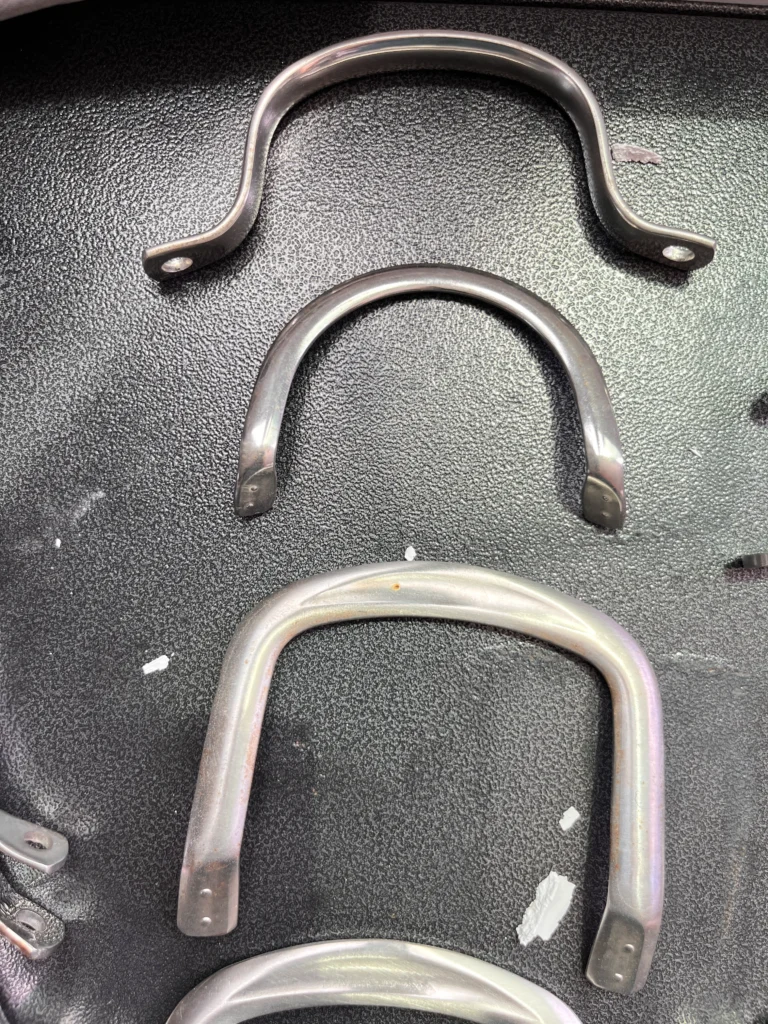
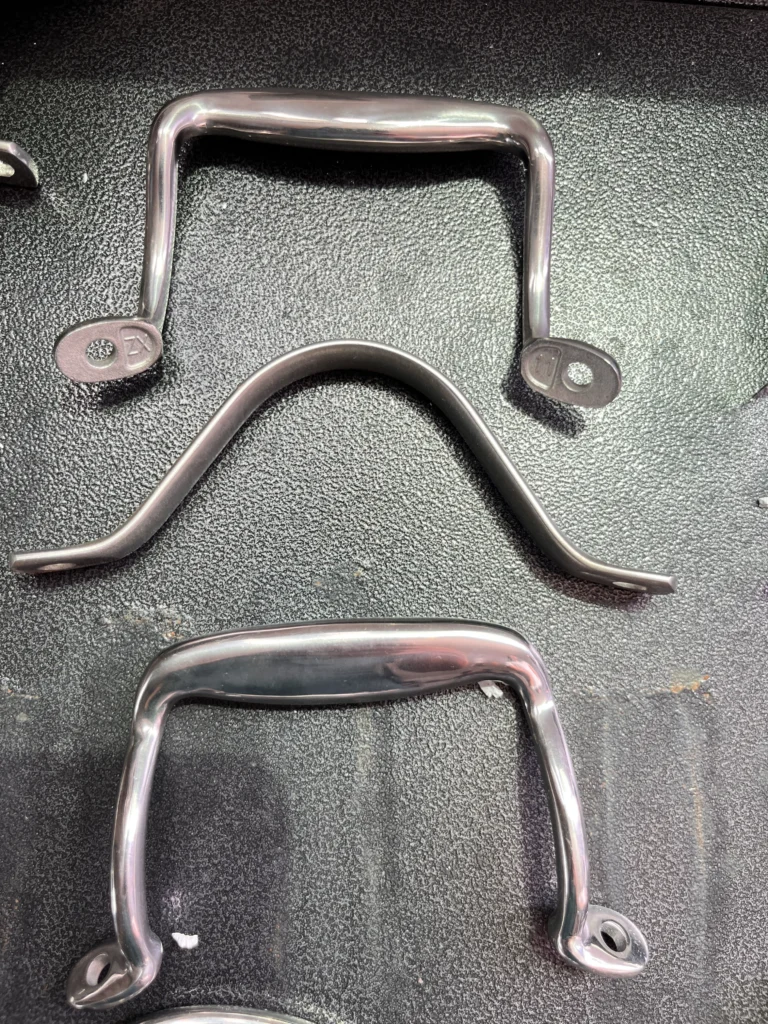

Ergonomic Considerations: The shape, angle, and size of the handle affect the usability greatly, especially when the casserole is full. Commercial designs should focus on solid gripping surfaces and even weight distribution.
Durability Factors: Attachment methods vary in strength and longevity:
- Welded handles offer sleek features but may weaken over time
- Riveted attachments are durable but they might be difficult to clean inside
- Cast integrated handles eliminate attachment concerns but affect heat distribution
Manufacturing Insights for Bulk Purchasing Partners
Understanding the production process can help wholesale partners create casserole programs by providing information for product development, quality assessment, and price strategies. Let’s examine the main production factors that affect the finished product.
Production Methods by Material
Different materials require distinct manufacturing approaches, each with implications for product characteristics and cost structures:
Stainless Steel Casseroles:
- Stamping and Deep Drawing: Most commercial stainless steel casseroles begin with single ply or triple-ply sheet metal that’s stamped and drawn into shape. This process is highly efficient for volume production but requires significant initial tooling investment.
- Multi-Ply Construction: Premium stainless products often incorporate aluminum or copper cores for improved heat distribution. These layers are bonded through pressure and heat in specialized presses before forming.
- Welding and Finishing: Handle attachment, edge rolling, and surface finishing require multiple specialized processes. The number of finishing steps directly impacts cost and aesthetic quality.
Cast Iron Casseroles:
- Sand Casting: Traditional production uses sand molds created from master patterns. This labor-intensive process creates the characteristic textured exterior but requires skilled craftspeople.
- Machining and Finishing: Raw castings require grinding, milling, and polishing to create proper lid fits and smooth cooking surfaces.
- Seasoning (for traditional cast iron): Initial oil application and heat treatment create the foundation for the non-stick surface and prevent rusting.
- Enameling (for enameled versions): Multiple layers of porcelain enamel are applied and fired at extremely high temperatures, requiring specialized equipment and expertise.
Aluminum Casseroles:
- Die Casting: Molten aluminum is forced into steel molds under pressure, creating complex shapes with consistent wall thickness.
- Anodizing: Electrochemical process that creates a durable, non-reactive surface layer.
- Non-Stick Application: Specialized coatings require precise surface preparation and controlled application environments to ensure durability.
Market Trends and Consumer Insights
Understanding current market dynamics and emerging trends is essential for professional kitchenware partners developing casserole programs. Let’s examine the key factors shaping the category’s future.
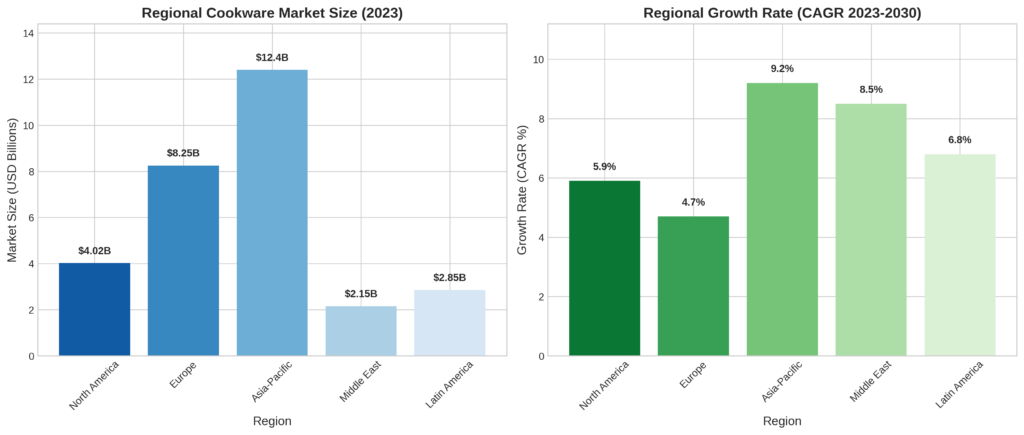
Global Market Trajectory
The global cookware market’s robust growth trajectory directly benefits the casserole category, with several factors driving expansion:
- Rising Foodservice Sector: Post-pandemic recovery in commercial food preparation has accelerated demand for durable, versatile cookware. Casseroles, with their multi-functionality, are experiencing particularly strong growth in this segment.
- Urbanization Effects: Increasing urban populations, particularly in developing regions, increase the need for efficient, multi-purpose cookware suitable for smaller living spaces.
- Premiumization Trend: Consumers and commercial buyers increasingly prioritize quality and durability over initial purchase price, supporting higher-end casserole offerings.
Regional variations in casserole demand present strategic opportunities for targeted product development:
- North America: Strong demand for premium materials and innovative features, with particular growth in cast iron and multi-ply stainless steel segments.
- Europe: Heritage brands and traditional materials dominate, with enameled cast iron maintaining significant market share despite premium pricing.
- Asia-Pacific: The fastest-growing region, with rising acceptance of Western cooking methods, is creating new demand for casseroles, especially in stainless steel and aluminum categories.
- Middle East & Africa: There is a growing need for specific designs that follow with regional cooking traditions, with a strong preference for heavy-gauge construction and excellent heat retention.
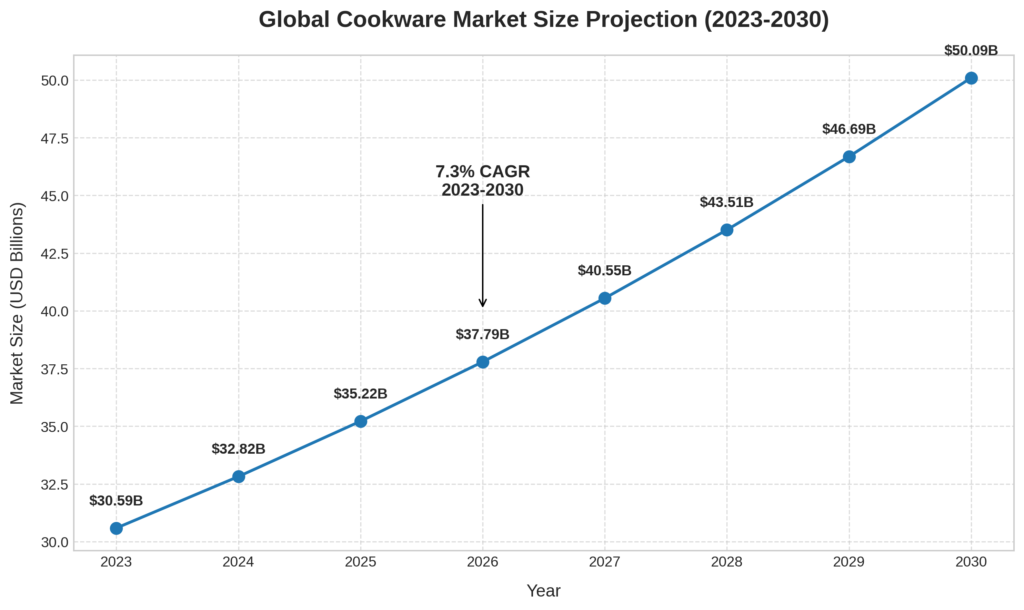
Wholesale and Distribution Strategies
For cookware partners, developing effective distribution strategies is as important as product selection itself. Let’s explore key considerations for maximizing casserole program success across different channels.
Channel-Specific Approaches
Different distribution channels require tailored strategies to optimize performance:
Traditional Retail:
- Assortment Planning: Brick-and-mortar retailers typically benefit from curated collections rather than extensive options. We recommend focused assortments of 3-5 casserole styles in 2-3 size options each, with clear good-better-best positioning.
- Merchandising Support: Physical displays, educational signage, and cross-merchandising guides significantly impact sell-through rates. Our research shows that casseroles displayed with complementary items (such as utensils or cookbooks) increase attachment rates by up to 23%.
- Seasonal Strategies: While casseroles sell year-round, promotional timing aligned with key cooking seasons (fall/winter holidays, wedding season) can drive significant volume increases.
E-commerce:
- Content Requirements: Online success demands comprehensive product information, including detailed specifications, multiple images, comparison charts, and ideally, video content demonstrating features.
- Expanded Assortments: Unlike physical retail, e-commerce can efficiently support broader product ranges. Digital-first retailers often succeed with 2-3 times the SKU count of traditional retail.
- Review Management: Customer reviews significantly impact conversion rates. Programs that actively solicit and manage reviews show 30-40% higher conversion rates than passive approaches.
Foodservice Supply:
- Specification Focus: Commercial buyers prioritize performance specifications and durability metrics over aesthetic considerations. Technical documentation should emphasize thermal efficiency, weight capacity, and warranty terms.
- Volume Incentives: Structured volume discount programs are essential for foodservice distributors who often supply multiple locations or chains.
- Replacement Programs: Establishing efficient systems for handling replacement parts (particularly lids and handles) creates valuable competitive differentiation in this channel.
Comparative Analysis: Casseroles vs. Other Cookware
For business partners developing comprehensive kitchenware programs, understanding how casseroles compare to and complement other cookware categories provides valuable context for assortment planning and marketing positioning.
Functional Comparison with Alternative Cookware
Casseroles offer distinct advantages and limitations relative to other cookware categories:
Casseroles vs. Saucepans:
- Capacity Advantage: Casseroles typically offer 30-50% greater volume than saucepans of similar diameter, making them more efficient for batch cooking.
- Heat Distribution: The wider diameter-to-height ratio of casseroles provides more even heat distribution across the cooking surface compared to taller, narrower saucepans.
- Versatility Trade-off: While casseroles excel at slow cooking, braising, and oven applications, saucepans offer better control for precision cooking techniques like sauce reduction.
Casseroles vs. Dutch Ovens:
- Construction Differences: Traditional Dutch ovens feature thicker walls and heavier construction than most casseroles, offering superior heat retention but at the cost of greater weight.
- Temperature Response: Casseroles, particularly in stainless steel or aluminum, respond more quickly to temperature changes than Dutch ovens, making them more versatile for techniques requiring temperature adjustment.
- Price Positioning: Premium Dutch ovens typically command 25-40% higher price points than comparable casseroles, creating distinct market positioning opportunities.
Casseroles vs. Sauté Pans:
- Depth Differential: Casseroles provide significantly greater depth than sauté pans, reducing splatter during vigorous cooking and accommodating larger food volumes.
- Lid Design: Casserole lids are typically designed for moisture retention during extended cooking, while sauté pan lids prioritize occasional use and easy storage.
- Handling Characteristics: Sauté pans feature long handles optimized for tossing and agitation, while casseroles employ dual short handles better suited for transfer between cooking surfaces.
Case Studies: Successful B2B Casserole Programs
Examining real-world success stories provides valuable insights for B2B partners developing their own casserole programs. The following case studies highlight different approaches that have delivered exceptional results across various market segments.
Restaurant Supply Distributor
Challenge: A foodservice distributor serving independent restaurants needed to develop a casserole program that balanced professional performance with competitive pricing to compete against direct-to-chef online suppliers.
Solution: We created a commercial-grade program with these key elements:
- Heavy-gauge stainless steel construction with aluminum-clad bases for optimal durability and heat distribution
- Standardized sizing compatible with commercial kitchen equipment and storage systems
- Volume-based pricing structure allowing the distributor to offer competitive rates to both small independents and multi-location operations
- Comprehensive warranty program with 48-hour replacement guarantee for defective products
Results:
- 35% increase in cookware category sales within the first year
- Significant market share gain against online competitors
- Enhanced customer loyalty, with 78% of first-time casserole buyers making additional purchases within 90 days
- Reduced customer acquisition costs through referral business
Key Insight: The warranty program proved to be a critical differentiator, addressing a significant pain point for commercial kitchens where equipment downtime directly impacts revenue. This service-oriented approach created value beyond the physical product.
Frequently Asked Questions
Based on our extensive experience working with B2B partners, here are answers to the most common questions about casserole programs:
What minimum order quantities should we expect for custom casserole programs?
Minimum order quantities (MOQs) vary significantly based on customization level and manufacturing process:
- Basic Branding (applying your logo to standard products): Typically 300 units per size/style
- Color Customization (custom colors on enameled products): Usually 500-1,000 units per color
- Structural Modifications (custom handles, lid designs): Generally 1,000-2,500 units
- Fully Custom Designs: Typically 3,000+ units with significant tooling investments
Many manufacturers offer tiered programs where initial orders can start at lower quantities with scaled pricing benefits as volume increases. For partners new to the category, we often recommend beginning with basic branding on proven designs before investing in structural customization.
How should we approach pricing strategy for casserole programs?
Effective pricing strategies balance several key factors:
- Channel Considerations: Different channels support different margin structures. Traditional retail typically requires 50-60% margins, while e-commerce can operate efficiently at 35-45% and foodservice often works with 25-35% margins.
- Price Architecture: Establishing clear good-better-best positioning helps consumers understand value propositions. We recommend approximately 30-40% price separation between adjacent tiers.
- Competitive Positioning: Benchmark against both direct competitors and adjacent categories that may serve as substitutes. Price positioning should align with genuine performance and feature differentiation.
Most successful programs incorporate strategic loss leaders (particularly in entry-level sizes) balanced with stronger margins on larger sizes and premium materials where value perception supports higher pricing.
What are the most common quality issues with casseroles, and how can we prevent them?
Quality control should focus on these common failure points:
- Handle Attachment: The junction between handles and vessel body represents the most common failure point, particularly with welded attachments. Specify and test to at least 3x the maximum filled weight of the vessel.
- Lid Fit: Inconsistent lid fit affects both performance and customer satisfaction. Require tolerance specifications of ±0.5mm or better on critical dimensions.
- Bottom Flatness: Warping or distortion of the base affects performance on modern cooking surfaces. Specify maximum deviation standards and test with calibrated equipment.
- Material Consistency: Particularly in multi-ply constructions, delamination can occur if bonding processes aren’t properly controlled. Require cross-section analysis as part of quality verification.
Implementing a formal quality assurance program with both production-line sampling and finished goods testing significantly reduces field failures. We recommend allocating 2-3% of program budget to quality verification processes.
How are sustainability concerns affecting the casserole market?
Environmental considerations are increasingly influencing both manufacturing practices and consumer preferences:
- Material Selection: Growing interest in recycled content, particularly in aluminum and stainless steel products. Leading manufacturers now offer options with 30-70% post-consumer recycled content.
- Production Processes: Energy-efficient manufacturing, water recycling systems, and reduced chemical use in finishing processes are becoming competitive advantages, particularly for premium positioning.
- Packaging Evolution: Sustainable packaging solutions using recycled and recyclable materials with minimal plastic content are increasingly expected, especially in premium market segments.
- Durability Emphasis: The “buy once, buy well” consumer philosophy aligns perfectly with high-quality casseroles, creating marketing opportunities focused on lifetime value and reduced replacement cycles.
Partners who proactively address sustainability through both product attributes and messaging can create meaningful differentiation, particularly with younger consumers and institutional buyers with formal sustainability commitments.
Conclusion and Call to Action
As we’ve explored throughout this comprehensive guide, casseroles represent far more than just another cookware category—they’re versatile kitchen workhorses with significant business potential for B2B partners across the global marketplace. From material selection and manufacturing considerations to market trends and distribution strategies, the humble casserole offers remarkable opportunities for differentiation, innovation, and growth.
Summary of Key Points
Let’s recap the essential insights we’ve covered:
The global cookware market is experiencing robust growth, projected at a 7.3% CAGR through 2030, with casseroles playing a pivotal role in this expansion. Stainless steel dominates with 27% market share, though multiple materials offer distinct advantages for different applications and price points.
Successful casserole programs require thoughtful consideration of several key dimensions:
- Product Development: Balancing material selection, feature integration, and design elements to create compelling offerings across price tiers
- Manufacturing Partnerships: Establishing relationships with capable producers who can deliver consistent quality and support customization needs
- Channel Strategy: Developing appropriate approaches for different distribution channels, from traditional retail to e-commerce to foodservice
- Market Positioning: Creating clear differentiation through thoughtful good-better-best hierarchies and distinctive feature sets
- Customer Education: Providing comprehensive information that helps partners and end-users understand product benefits and applications
The most successful B2B casserole programs share common characteristics: they’re built on deep market understanding, they balance innovation with proven fundamentals, and they provide comprehensive support throughout the value chain.
Bonray Cookware’s Unique Value Proposition
At Bonray Cookware, we bring unique advantages to B2B partnerships in the casserole category:
Our extensive manufacturing experience in stainless steel cookware provides unmatched technical expertise and quality assurance. With over two decades in the industry, we’ve refined our production processes to deliver exceptional value across price points.
Our comprehensive product development capabilities enable us to create distinctive offerings tailored to specific market needs. Whether you’re seeking exclusive designs for premium positioning or efficient production for value-oriented programs, our team can develop solutions that align perfectly with your business objectives.
Our strong supply chain relationships ensure reliable material sourcing and consistent production capacity, even during challenging market conditions. This operational stability translates to dependable inventory availability for our partners.
Perhaps most importantly, our collaborative approach to business partnerships focuses on long-term mutual success rather than transactional relationships. We invest in understanding your specific market challenges and opportunities, developing customized solutions that drive sustainable growth.
Next Steps
Ready to elevate your casserole program? Here’s how to get started:
- Contact our B2B team at tiffany@bonraycookware.com to schedule a consultation with our product specialists.
- Request our catalog featuring our complete casserole collections across materials and price points.
- Explore customization options by sharing your specific requirements for branding, features, or exclusive designs.
- Visit our showroom (virtually or in person) to experience our products firsthand and discuss your specific market needs.
The casserole category offers exceptional business potential for partners who approach it with strategic insight and quality products. At Bonray Cookware, we’re committed to helping you realize that potential through collaborative partnership and industry-leading manufacturing expertise.
Let’s cook up success together.
